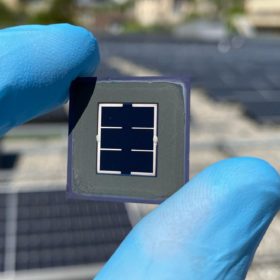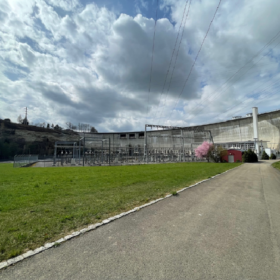Module brands that earn the trust of solar installers
The latest global PV installer survey by Germany’s EUPD Research offers a hint of the solar brands which installers, mostly based in Europe, gravitate toward. This year’s report also ventured to South Africa and considered mounting systems for the first time.
Titanium oxide nanoparticle-based perovskite PV cell with 24.05% efficiency
A new perovskite PV cell based on titanium dioxide nanoparticles exhibits low efficiency losses when scaled up from cell to module.
EPFL achieves 29.2% efficiency for tandem solar cell with fully textured silicon
Scientists in Switzerland made significant progress with an approach to perovskite-silicon tandem cell design that they say could eventually be integrated into existing silicon PV manufacturing. They have announced the achievement of a 29.2% cell efficiency – not far from the overall record for tandem cells, and verified by Germany’s Fraunhofer ISE.
Electron blocking for 18.5%-efficient carbon-electrode perovskite solar cell
Scientists in Germany and Switzerland have developed a perovskite solar cell with a carbon electrode that achieved 18.5% efficiency. It also retained 82% of this after 500 hours of continuous illumination. While a long way behind what has been achieved with other perovskite solar devices, the cell is produced via all low-temperature processes that could likely be scaled into low-cost, large-scale manufacturing – making the approach one worth pursuing further.
Ionic liquid-based perovskite solar cell with 22.86% efficiency
A Swiss-Japanese research group has used ionic liquids doping to improve the efficiency and stability of perovskite solar cells. Their champion device showed an open-circuit voltage of 1.16 V, a short-circuit current of 24.03 (mA cm−2), and a fill factor of 0.818. It was also able to retain around 95% of its initial efficiency after 1,000 hours of operation.
Hydro-powered hydrogen production in Switzerland
Groupe E will build an $8.5 million hydrogen production facility in the Swiss canton of Fribourg, featuring two polymer electrolyte membrane (PEM) electrolyzers provided by H-Tec Systems.
Pure solid state batteries from Switzerland
Swiss Clean Battery is set to start commercial production of its pure solid state batteries in Switzerland. The batteries are based on a protected electrolyte made of a solid ion conductor, which helps to maintain internal resistance and capacity. The fixed ion conductor is formed in the battery cell itself, similar to a multi-component adhesive.
Switzerland plans winter bonus for PV systems with a tilt angle of at least 75 degrees
The Swiss Federal Council has the task of standardizing the incentives for renewable energy and has now started the related parliamentary process. A winter bonus for photovoltaic systems may be introduced in the future.
Solar caravan powering the electric vehicle that tows it
The solar modules for the solar array were supplied by Chinese manufacturer Longi, which is a major partner in the project.
Swiss manufacturer unveils 500W solar module with 23.2% efficiency
Megasol said the solar module relies on new back-contact technology that is able to reduce internal resistance, ohmic losses and cell spacing.










